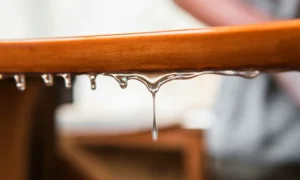In high-temperature systems such as furnaces, kilns, and boilers, efficiency depends on how well heat is transferred throughout the process. A key factor in that efficiency is emissivity, the ability of a surface to radiate heat energy. Surfaces with high emissivity distribute heat more evenly, allowing equipment to reach target temperatures faster and use less fuel.
High-emissivity coatings (HECs) are engineered to improve this property by modifying the surface of refractory or metallic materials. They increase the amount of radiant energy reflected back into the process zone, which enhances temperature uniformity and reduces wall losses. The result is better thermal performance, lower operating costs, and longer refractory life.
An example of this approach can be seen in Chase Nedrow, the exclusive North American provider of Emisshield high‑emissivity coatings, offering integrated refractory systems and advanced thermal solutions originally developed from NASA’s thermal protection technology. In industrial furnaces and process heaters, coatings of this type have shown measurable gains in efficiency while supporting cleaner combustion and reduced maintenance.
As more facilities aim to cut energy waste and extend equipment lifespans, high-emissivity coatings have become an essential part of modern refractory design and sustainability efforts.
Understanding Emissivity and Thermal Radiation
Emissivity measures how effectively a material emits thermal radiation on a scale from 0 to 1. Low-emissivity surfaces, such as polished metals, reflect heat unevenly and require more energy to maintain consistent temperatures. High-emissivity surfaces, on the other hand, radiate heat evenly, improving temperature control and reducing fuel use.
A typical refractory surface might have an emissivity of about 0.3, while a coated surface can reach 0.85 or higher. This difference means faster heating, improved process stability, and longer refractory life. For instance, in a reheat furnace or biomass boiler, high-emissivity coatings help maintain even heat distribution, reducing thermal stress and enhancing reliability.
By optimizing how surfaces manage radiative heat, these coatings play a critical role in improving both the performance and longevity of industrial heating systems.
What Makes a Coating “High-Emissivity”?
High-emissivity coatings are engineered with advanced ceramic and oxide-based compounds, often enhanced with rare-earth additives that enable them to absorb and re-emit heat energy efficiently. This composition creates a stable, radiation-active surface that performs well under extreme temperatures, helping industrial equipment maintain consistent heat distribution and reduced fuel demand.
One of the most recognized examples is Emisshield, a technology originally developed from NASA’s Space Shuttle heat protection program. Its formulation allows refractory linings, metals, and fiber modules to operate at temperatures above 2000°F (1093°C) while maintaining high emissivity and durability. The coating bonds strongly to various substrates, protecting them from oxidation and thermal degradation.
By converting short-wave energy into long-wave infrared radiation, these coatings recycle heat within the process chamber rather than allowing it to escape. This conversion increases thermal efficiency, reduces heat loss, and contributes to longer refractory life in furnaces, kilns, and process heaters.
Key Industrial Applications
Furnaces and Kilns
High-emissivity coatings improve heat transfer within furnaces and kilns, allowing for faster warm-up cycles and more uniform heating. By reducing heat loss through refractory walls, they help maintain lower surface temperatures, which extends refractory life and reduces maintenance needs. In steel reheat furnaces and ceramic kilns, this leads to consistent product quality and lower fuel costs.
Boilers and Process Heaters
In industrial boilers and process heaters, high-emissivity coatings promote more complete combustion and better temperature balance throughout the chamber. This results in reduced fuel consumption, lower CO₂ emissions, and longer equipment life, especially in systems that operate continuously or at variable loads.
Power Generation and Biomass Plants
Applied to refractory linings in biomass boilers and heat-recovery systems, these coatings help maintain stable operating conditions and minimize energy loss. Plants benefit from shorter downtime, greater reliability, and improved thermal efficiency across power generation processes.
Chemical and Petrochemical Processing
In chemical and petrochemical facilities, high-emissivity coatings provide thermal stability and corrosion resistance in harsh, high-temperature atmospheres. They protect both refractory linings and metallic components, ensuring longer service life and consistent performance under demanding process conditions.
Performance and Operational Benefits
Improved Thermal Efficiency
High-emissivity coatings re-radiate energy back into the process zone, improving overall heat utilization. This can result in measurable energy savings of 5 to 15 percent, depending on operating conditions and system design. The enhanced heat balance also allows furnaces and boilers to maintain consistent performance at lower fuel input levels.
Extended Equipment Life
By lowering surface temperatures and distributing heat more evenly, these coatings help reduce thermal shock, hot spots, and material fatigue. The result is fewer relines, less downtime, and longer service life for refractory linings and metallic components, improving operational reliability over time.
Environmental and Sustainability Impact
Better energy efficiency translates directly into lower fossil-fuel consumption and reduced carbon emissions. Because equipment runs cooler and lasts longer, high-emissivity coatings also support ESG and sustainability goals, helping industrial facilities minimize their environmental footprint while improving process performance.
Application Methods and Best Practices
Proper application is critical to achieving the full benefits of high-emissivity coatings. Surfaces should be cleaned, dried, and free of oil or debris before coating. Depending on the equipment’s geometry and environment, coatings should be applied using HVLP or airless spray systems, following manufacturer specifications for film thickness and curing.
Controlled curing and temperature management are essential to ensure strong adhesion and stable emissive properties. Plant managers should also schedule regular inspections to confirm coating integrity and identify early signs of wear or damage.
Quality and Testing Standards
The performance of high-emissivity coatings is verified through emissivity measurements such as ASTM C835 and infrared thermography. Additional laboratory tests assess adhesion strength, abrasion resistance, and thermal stability under high heat conditions.
Working with an experienced engineering partner ensures coatings are properly selected, applied, and tested for each application, leading to predictable results and long-term performance reliability.
The Future of High-Emissivity Coatings
Emerging innovations in nanotechnology and composite coating systems are pushing emissivity performance to new levels. These next-generation coatings offer greater durability, enhanced temperature tolerance, and improved bonding with a variety of substrates.
Future systems are expected to work seamlessly with digital thermal monitoring and predictive maintenance tools, allowing engineers to track coating performance and detect inefficiencies in real time. As industries continue to pursue sustainability and decarbonization goals, high-emissivity coatings will play an even greater role in improving energy efficiency and reducing environmental impact.
Conclusion
High-emissivity coatings are more than a surface treatment; they are a performance-driven technology that improves heat transfer, lowers fuel use, and extends equipment life. By combining proven refractory expertise with innovative coating solutions, Chase Nedrow helps industrial facilities operate more efficiently and sustainably.
Frequently Asked Questions
- What industries benefit most from high-emissivity coatings?
High-emissivity coatings are widely used in steel manufacturing, power generation, biomass energy, chemical processing, and ceramics production. Any process that involves high temperatures and radiant heat transfer can benefit from improved thermal efficiency and longer refractory life.
- How much energy can these coatings actually save?
Energy savings typically range from 5 to 15 percent, depending on the furnace design, operating temperature, and coating application. Plants often notice faster warm-up times, reduced fuel use, and more consistent temperature control after applying high-emissivity coatings.
- Can high-emissivity coatings be applied to existing equipment?
Yes. These coatings can be retrofitted onto existing refractory or metal surfaces, provided the substrate is properly prepared and in good condition. Surface cleaning, drying, and curing are critical steps to ensure strong adhesion and lasting performance.
- What temperatures can high-emissivity coatings handle?
Most industrial-grade coatings, including Emisshield, perform reliably up to 2000°F (about 1090°C) or higher. They maintain high emissivity and structural stability even under repeated thermal cycling and harsh process conditions.
- How long does a coating last before it needs reapplication?
Lifespan depends on the operating environment, but with proper application and maintenance, coatings can last several years before requiring touch-ups or reapplication. Regular inspections help ensure continued performance.
Read More From Techbullion



































